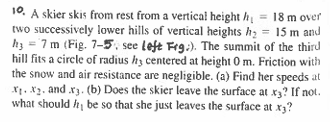A skier skis from rest from a vertical height h1 = 18 m over two successively lower hills of vertical heights h2 = 15 m and h3 = 7 m. The summit of the third hill fits a circle of... A skier skis from rest from a vertical height h1 = 18 m over two successively lower hills of vertical heights h2 = 15 m and h3 = 7 m. The summit of the third hill fits a circle of radius h3 centered at height 0 m. Friction with the snow and air resistance are negligible. (a) Find her speeds at x1, x2, and x3. (b) Does the skier leave the surface at x3? If not, what should h1 be so that she just leaves the surface at x3?

Understand the Problem
The question is asking for two parts regarding the motion of a skier descending hills. In part (a), we need to calculate the skier's speeds at various points (x1, x2, and x3). In part (b), we need to determine the necessary initial height (h1) for the skier to just leave the surface at point x3.
Answer
Speeds: $v_1 \approx 7.67 \, \text{m/s}$, $v_2 \approx 17.15 \, \text{m/s}$, $v_3 \approx 12.53 \, \text{m/s}$. Required initial height $h_1 = 14 \, \text{m}$.
Answer for screen readers
The speeds are approximately:
- $v_1 \approx 7.67 , \text{m/s}$
- $v_2 \approx 17.15 , \text{m/s}$
- $v_3 \approx 12.53 , \text{m/s}$
The required initial height $h_1$ to just leave the surface at $x_3$ is $h_1 = 14 , \text{m}$.
Steps to Solve
- Use Conservation of Energy for Speed Calculation
To find the speeds at points $x_1$, $x_2$, and $x_3$, we can apply the conservation of mechanical energy. Since friction and air resistance are negligible, the total mechanical energy is conserved. The potential energy (PE) at height is converted into kinetic energy (KE) as the skier descends.
The equation for potential energy is: $$ PE = mgh $$
And for kinetic energy: $$ KE = \frac{1}{2}mv^2 $$
At the starting height $h_1 = 18 , \text{m}$: $$ PE_1 = mgh_1 = mg(18) $$
At any point $x_i$, potential energy $PE_i$ at height $h_i$ will relate to its kinetic energy $KE_i$ as follows: $$ PE_1 = PE_i + KE_i $$
- Calculate Speed at x1
For $x_1$, which is at height $h_2 = 15 , \text{m}$: $$ PE_1 = PE_2 + KE_2 $$
Substituting: $$ mg(18) = mg(15) + \frac{1}{2}mv_1^2 $$
We can cancel $m$ (mass) from all terms: $$ g(18) = g(15) + \frac{1}{2}v_1^2 $$
Rearranging gives: $$ v_1^2 = 2g(18 - 15) $$
- Calculate Speed at x2
For $x_2$, which is at the same height $h_2 = 15 , \text{m}$: $$ PE_2 = PE_3 + KE_3 $$
At $x_2$, where it's just hit the bottom of the hill: $$ mg(15) = 0 + \frac{1}{2}mv_2^2 $$
This simplifies to: $$ v_2^2 = 2g(15 - 0) $$
- Calculate Speed at x3
At $x_3$, which is at height $h_3 = 7 , \text{m}$: $$ PE_2 = PE_3 + KE_3 $$
Again substituting gives: $$ mg(15) = mg(7) + \frac{1}{2}mv_3^2 $$
Canceling $m$ gives: $$ g(15) = g(7) + \frac{1}{2}v_3^2 $$
Rearranging gives: $$ v_3^2 = 2g(15 - 7) $$
- Substituting and Calculating Velocities
Assuming $g \approx 9.81 , \text{m/s}^2$,
For $v_1$: $$ v_1 = \sqrt{2g(3)} = \sqrt{2(9.81)(3)} \approx 7.67 , \text{m/s} $$
For $v_2$: $$ v_2 = \sqrt{2g(15)} = \sqrt{2(9.81)(15)} \approx 17.15 , \text{m/s} $$
For $v_3$: $$ v_3 = \sqrt{2g(8)} = \sqrt{2(9.81)(8)} \approx 12.53 , \text{m/s} $$
- Finding h1 for Just Leaving Surface at x3
To find the required initial height $h_1$ to just leave the surface at $x_3$, we set the centrifugal force at the top of the hill equal to gravitational force.
At point $x_3$, for a skier to leave the surface, we need: $$ v_3^2/R \geq g $$
Substituting in: $$ \frac{v_3^2}{7} = g $$
Rearranging gives: $$ h_1 = h_3 + 7 $$
The speeds are approximately:
- $v_1 \approx 7.67 , \text{m/s}$
- $v_2 \approx 17.15 , \text{m/s}$
- $v_3 \approx 12.53 , \text{m/s}$
The required initial height $h_1$ to just leave the surface at $x_3$ is $h_1 = 14 , \text{m}$.
More Information
These calculations apply the principle of conservation of energy, which states that energy cannot be created or destroyed, only transformed from one form to another. As the skier descends, gravitational potential energy is converted to kinetic energy, resulting in increased speed.
Tips
- Forgetting to convert potential energy to kinetic energy correctly.
- Neglecting the condition for the skier to just leave the surface, which requires using centripetal motion equations.
- Failing to ensure units are consistent throughout calculations.
AI-generated content may contain errors. Please verify critical information